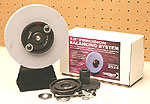 |
The Oneway Precision Balancing System is a simple way to solve a problem too many woodworkers do not know that they have.
Click image to enlarge |
Oneway's Precision Balancing System
Fixing a problem you may not know about
Text & Photos by Tom Hintz
For many of us, balancing grinding wheels may not seem necessary, until you try it. Initially, I also had reservations regarding the importance of balancing. After using the Oneway Precision Balancing System to balance the wheels I had been using on my grinder for months, I am convinced.
Though any grinding wheel benefits from balancing, the process is particularly important for those used to sharpen tools. The wheels balanced in this review will be used primarily with the Oneway Wolverine Grinding Jig.
Initial Impressions
 |
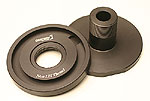 |
(Top) This simple axle with bearings arrangement allows highly precise balancing of grinding wheels.
(Bottom) Precision machined hubs are the key to this system.
Click image to enlarge |
The Oneway Balancing System is a deceptively simple looking device that employs basic principles of gravity to identify and correct even small weight inconsistencies in grinding wheels.
The stand, axle and bearings on which the wheel is balanced are nicely made but not the real stars of this kit. The two-piece flanges that fit into the 1"-diameter center hole of the wheels are ingeniously designed and finely crafted from high-quality aluminum.
Even the hardware pack, nuts, bolts washers and an Allen wrench, are all very good quality and sized specifically for use with the Oneway Balancing System.
Instructions
The simplicity of the Oneway Balancing System means a complete set of instructions can be printed on a single sheet. Use this tool as described in the instructions and balancing grinding wheels becomes a quick, simple task.
In The Shop
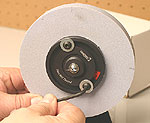 |
The screw assemblies work as counterweights and stay in position when the wheel is mounted for use.
Click image to enlarge |
After assembling the stand and its axle, the nuts, bolts and washers were assembled into the grooves of the outer flange pieces. The initial setting for the bolts is 180-degrees from each other on the axis line. The flanges were then assembled to the grinding wheels. Left and right-hand threaded flanges are included. Since most grinders are equipped with two different grit wheels, make sure the correct flange is installed in each for their position on the grinder.
The wheel and flange assemblies are placed on the stand and allowed to stop turning. Gravity brings the heaviest portion of the wheel to the bottom.
Pencil marks are made on the wheel at the 3 – 9 and 12 O'clock positions for reference later. Move both screw assemblies towards the 12 o'clock position slightly and check the balance. Repeat that process as needed.
During testing, four brand new grinding wheels (6"-diameter X ¾"-wide) were balanced. I had no trouble getting all of them to remain motionless on the balancing stand when turned to
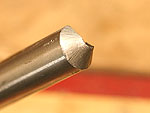 |
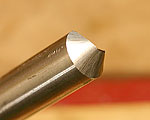 |
(Top) Ground on an unbalanced wheel the marks are rough and the cutting edge uneven.
(Bottom) The same wheel after balancing produced a fine, consistent grinding pattern and a clean cutting edge.
Click images to enlarge |
any position, indicating they are perfectly balanced.
To test the impact of balancing grinding wheels a single bowl gouge was sharpened using two different sets of brand new grinding wheels before and after balancing. All of the wheels were installed on the same grinder and trued to be sure they were round before being balanced.
The edge was ground on each wheel before and after balancing for comparison. In each case, the finish on the tool improved when ground on a balanced wheel.
One grinding wheel (a bargain brand purchased locally) was sufficiently out of balance to produce a small vibration of the grinder. It also left a noticeably rougher finish on the gouge. After balancing on the Oneway System, the vibration was gone and the finish left on the gouge became as smooth as with the other balanced wheels.
A pair of Oneway grinding wheels, specifically designed for sharpening, were also balanced. While the Oneway wheels were closer to balance initially, the Precision Balancing System was able to perfect them quickly.
Conclusions
The Oneway Precision Balancing System cures a problem too many of us do not know we have. Balancing grinding wheels is obviously good for the well being of the grinder itself but appears to be equally important
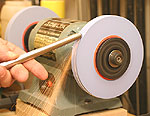 |
Until I ground a tool before and after balancing the wheels this did not seem like an important issue. It does now!
Click image to enlarge |
for the tools being sharpened on them. Being able to achieve a sharp edge and fine finish quickly means less material is removed from the tool at each sharpening. That extends the useful life of expensive cutting tools and makes the Oneway Precision Balancing System even more attractive with a price of only $57.50 (US – 12-23-2004).
The Oneway Precision Balancing System is available in versions to fit ½", 5/8" and ¾"-diameter grinder shafts. The wheels must have a 1"-diameter center hole regardless of grinder shaft size. Individual flange assemblies are also available for the multi-grinder shop.
Visit the Oneway Mfg. web site to see more of their extensive line of turning-related tools and equipment. www.oneway.ca.
Do you have a comment about this page? - Email Me!
Back to the Tool Reviews List
|
![]()







